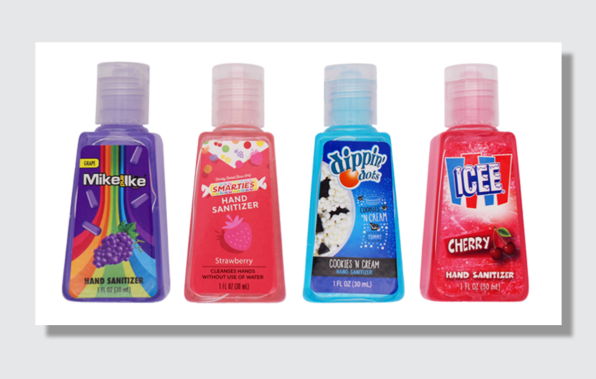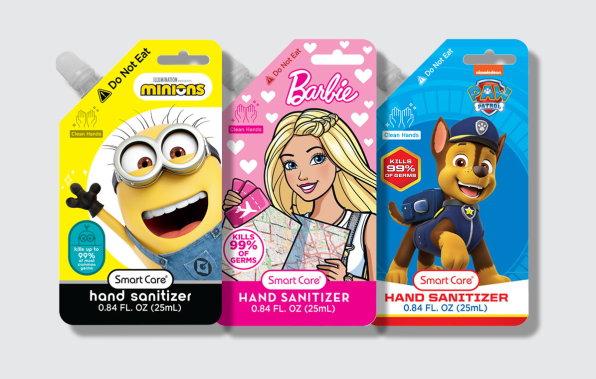Under no circumstances should you ever drink hand sanitizer. You’d think that’s a given, and yet, hand sanitizer companies have been packaging their product in containers that imply it’s food and using all sorts of cartoon branding to attract children.
While there are no widespread reports of children accidentally drinking hand sanitizer, the problem is serious enough that both Canadian health experts and the FDA have released warnings to consumers.
“The agency has discovered that some hand sanitizers are being packaged in beer cans, children’s food pouches, water bottles, juice bottles and vodka bottles,” the FDA writes. “Additionally, the FDA has found hand sanitizers that contain food flavors, such as chocolate or raspberry.”
When we reached out to the FDA for clarification and examples, a representative pointed us to Google image search—which was indeed all it took to dig up several egregious examples.
Tasty scents
Alcohol is the component that provides hand sanitizer’s sterilizing properties, and scents are often added to hide the smell of said alcohol.
But the alcohol in hand sanitizer is sourced differently than what’s in our spirits, which means you can’t drink it. Sanitizer uses either isopropyl alcohol, which can cause blindness or kidney damage, or a form of ethyl alcohol, which is in beer and wine but is often chemically altered in hand sanitizer so it will taste terrible. And even though methanol is technically banned in hand sanitizer in the U.S., it sometimes sneaks in, causing poisoning when consumed. And of course, hand sanitizer has all sorts of other additives that might be toxic to consume too.

Despite the fact that you should never ingest it, sanitizer is being sold in licensed scents from Mike and Ikes, Junior Mints, Tootsie Roll, Smarties, Blow Pops, and Dippin’ Dots. Despite the label of “hand sanitizer,” they look and smell like candy. “It’s dangerous to add scents with food flavors to hand sanitizers which children could think smells like food, eat and get alcohol poisoning,” says FDA Commissioner Stephen M. Hahn, M.D., in a public statement. We first came across these products on a meme site mocking their existence, meaning even the collective wisdom of the internet knows such products are dangerous.
We reached out to the Tootsie Roll company, Just Born (the company behind Mike and Ike), and Nestlé (which owns the Smarties brand). None responded to our request for comment, but a Just Born representative confirmed that the sanitizer was the result of a typical licensing agreement, in place before the COVID-19 pandemic. In other words, Just Born is making money by allowing its branding to be used on sanitizer—and the same is presumably true for its peers.
Enticing packaging
But in the most dangerous cases, companies are combining branding with packaging design that looks ready to eat. The most egregious examples we found are being sold under the SmartCare brand, which is owned by Ashtel Studios.
SmartCare licenses major kid-friendly characters and brands, including Thomas the Tank Engine, Minions, Trolls, Paw Patrol, Hot Wheels, and Shopkins (which include anthropomorphic strawberry, popcorn, and cupcake characters).

We reached out to Anish Patel, CEO of Ashtel Studios, to ask the most obvious question: Why? Why put these cartoons, and even foods, onto sanitizer packaging? And why would you put sanitizer into what looks a whole lot like a food pouch?
The lure of licensing
As Patel explains, SmartCare first launched in 2006 selling a musical toothbrush to help kids brush their teeth for two minutes at a time. But it wasn’t until the company began licensing—striking its first deal with the Smurfs—that it took off. Into 2009 and 2010, Patel set his sights on Justin Bieber, successfully licensing his likeness and music to attract tweens to SmartCare’s toothbrush.
More brands and celebrities—such as Mattel and Lady Gaga—followed. More products did, too. First, tissues. And then, around 2014, hand sanitizer. The company sold one-ounce bottles that clipped onto kids’ backpacks.
Patel argues that putting characters a child knows onto a product such as hand sanitizer makes it more likely to be used. “There are certain cartoons [kids] relate to,” says Patel. “And when there’s a product with that character, kid reactions and acceptance of that product are different.”
That makes some sense. A child who loves Paw Patrol will gravitate to, and perhaps trust the contents of, a Paw Patrol sanitizer more than a plain bottle. But what about the Shopkins characters—the aforementioned strawberry and popcorn—on the bottles? “Having a character on a product, versus [presenting a product as] edible, are two different things,” argues Patel. “We make toothbrushes and tissues [with Shopkins characters]; children do not eat those products.” Patel adds that, unlike some of his competitors on the market, SmartCare sanitizers don’t smell like food. They smell like sanitizer, and the alcohol inside is denatured to taste terrible were a child to try it. Believing these protections are enough, Patel insists the company won’t stop using these characters in the future.
As for the potentially more egregious error—the hand sanitizer pouches—those have already been pulled from the market. Patel says the only reason these pouches were put into production was that SmartCare ran out of bottles as COVID sparked demand for sanitizer. The only option they could find by April was this pouch, for a single run that has since been discontinued.
“We had a concern about the shape of the packaging being misleading, but after we did a quick study on the product—because we didn’t have too much time to spend on market research—we had feedback it would be a great product,” says Patel. “Literally within minutes of us getting the first [complaint] call, we swapped to bottles immediately.”
SmartCare is just one offender in this space, but they do not plan to end their licensing agreements on hand sanitizers any time soon—nor will they discontinue the use of food-inspired Shopkins on bottles. “It’s part of our business,” says Patel. “It’s not something we’re going to walk away from.”








 User Center
User Center My Training Class
My Training Class Feedback
Feedback












Comments
Something to say?
Log in or Sign up for free